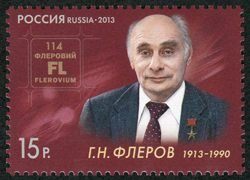|
|
Vol.
35 No. 4
July-August 2013
The Joint Working Party (JWP), an ad hoc committee of experts drawn from the ranks of IUPAC and IUPAP, was created in 2005 and charged with the notoriously difficult task of assessing the claims and assigning priority to the discovery of new elements with atomic numbers greater than 111. This is not a trivial endeavor since the detection and unequivocal identification of isotopes of the so-called superheavy elements, having transient lifetimes and often being generated one atom at a time, is quite challenging. In 2011, after careful consideration of all the available data, the JWP adjudicated the discovery of elements 114 (flerovium) and 116 (livermorium) to the teams of nuclear scientists working collaboratively at the Joint Institute for Nuclear Research (JINR) in Dubna, Russia, and the Lawrence Livermore National Laboratory in California, USA. The names of the newest members of the periodic club and their symbols (Fl and Lv, respectively) were officially approved by IUPAC in May of 2012, with the former paying tribute to the Flerov Laboratory of Nuclear Reactions at the JINR, named in turn after the prominent Russian physicist Georgiy N. Flerov (1913–1990).
 |
The stamp illustrated in this note, issued on 21 January 2013, commemorates the birth centennial of Flerov (whose birthday was actually on 2 March 1913) and is the first ever showing the name and symbol of element 114. Flerov was born in Rostov-on-Dov, a port city in Southwestern Russia, not far from the Sea of Azov. He studied nuclear physics at the Leningrad Polytechnic Institute, worked for a while in the laboratory of the legendary nuclear physicist Igor Kurchatov (the “father of the Soviet atomic bomb”) at the Russian Academy of Sciences and, together with Konstantin Petrzhak, discovered in 1940 the spontaneous fission of uranium. Following service in the Soviet Army during the Second World War and pioneering research in heavy-ion physics at the Institute of Atomic Energy in Moscow, he became the founding director of the Laboratory of Nuclear Reactions at the JINR, a position he held for more than 30 years (1957-1989). With due respect to the provisional systematic nomenclature devised by IUPAC for newly synthesized elements, flerovium is clearly an excellent choice for the element formerly known as ununquadium!
Written by Daniel Rabinovich <[email protected]>.
Page
last modified 29 August 2013.
Copyright © 2003-2013 International Union of Pure and Applied Chemistry.
Questions regarding the website, please contact [email protected]
|